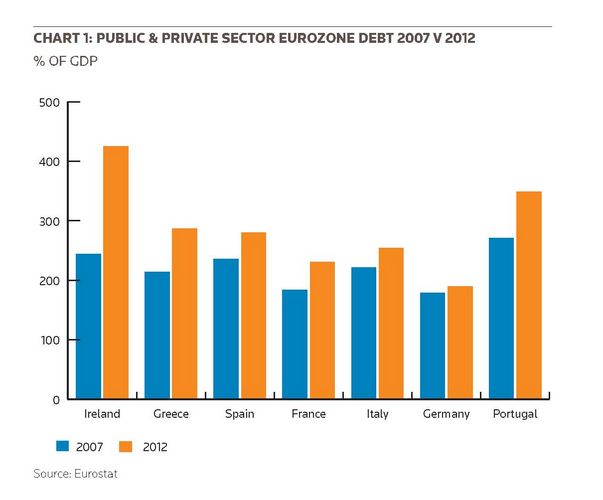The sovereign debt crisis may be cooling, but the eurozone could yet burn its fingers on the red-hot risks faced by banks in the peripherals.
To see the digital version of this report, please click here.
To purchase printed copies or a PDF of this report, please email gloria.balbastro@thomsonreuters.com.
While the sovereign debt crisis has cooled off, the eurozone has yet to deal with the direct link between sovereign and financial sector risk. The growing correlation between national creditworthiness and domestic banking sectors has eroded much of the cross-border banking market of the single currency bloc, leaving the viability of the banking sectors in peripheral eurozone countries open to question. As economic growth has gradually resumed in the eurozone, the regulatory imperative has shifted from one of banking sector support to understanding the timing for withdrawal of cheap liquidity provided by the European Central Bank.
Some progress has been made in rebuilding the balance sheets of eurozone lenders, particularly in peripheral countries (see table 1) but non-performing loan ratios have also risen and, as in the case of Spain at the end of September, continue to rise and remain a long way off what has been achieved in the US.
Additionally, lending across the bloc has dropped by an estimated €2.2trn since 2008, with the latest figures showing lending across the eurozone had fallen consecutively in July and August this year (by 1.9% and a further 2.2%, respectively) and private sector lending at record lows since records began in 1992.
There is a long road ahead before normal service resumes and confidence is restored to enable banks in peripheral countries to serve the needs of the economy and the business of banking becomes fully viable.
The level of support on which Europe’s banking system as a whole is dependent is startling (see table 2) and in the wake of the US Federal Reserve’s announcement that tapering of quantitative easing is to be deferred, is unlikely to be withdrawn soon. Credit default swap premiums have jumped across the currency bloc since the crisis, but it is between core and peripheral countries and between key lenders and smaller competitors in peripheral countries where the difference is the starkest.
The result means that the difference in borrowing costs between Germany and Spain is still close to 2.5% compared with a fraction of that two years ago.
Quest for yield
Even though bank deposits have increased across the board, making deposit funding an affordable option for many banks, the level is not sustainable to allow even a partial withdrawal of central bank-funded liquidity.
“The ECB’s two LTROs expire in 2015 but given the current state of affairs, it is unlikely that all banks will be able to repay the whole amount by that time,” said Stefan Best, managing director of Standard & Poor’s credit market services for Europe.
The extent of the problem is clear. Bankers are confident there is demand for assets of nationalised bad banks and for funding smaller banks in peripheral European countries, albeit slow and selective, and driven largely by the recurring post-crisis period theme of the quest for yield – in the case for example the resale of packages of non-performing loans by some of Germany’s banks in 2010 and 2011.
Mid-sized Spanish lender Banco Popular Espanol’s pioneering – the first launch of its kind for Europe since new capital requirement rules were agreed – Additional Tier 1 capital issuance at the beginning of October for example saw the bank pay over 11.5% for the €1.5bn it borrowed. The sustainability of funding with costs at this level for smaller banks on the periphery while interest rates remain low is highly questionable.
There were additional potential stumbling blocks on the horizon, including “European economic news which could affect sovereign credit worthiness, as well as general risk appetite for exposure for certain geographies or sectors”, said Mark Geller, head of European financial institutions syndicate at Barclays, and bookrunner for the Banco Popular transaction.
Expecting a sea change
Geller’s pragmatism around appetite for investment in a banking sector that is seeing renewed market interest is not uncommon. Although investors are reviewing options on a case-by-case basis, both by jurisdiction and individual bank analysis, they appear more willing to invest in a sector with improved balance sheets and that continues to benefit, for now at least, from apparently unreserved ECB support.
However, with the first asset quality review since 2009 and the results of bank stress tests since 2010, before the ECB takes over regulatory supervision of the banking system, 2014 could present a high watermark that causes a fresh round of consolidation across the sector.
“There is a significant number of banks that rely on LTRO, and while these are not zombie banks per se they will have difficulties to access funding and capital markets,” said Carlo Mareels, director of European debt capital markets at RBC Capital Markets.
Perhaps strangely at odds with the regulatory imperative in some European countries to diversify the banking market and increase choice for customers, many see this as inevitable. Spain, which had 53 individual banks and savings banks in 2009 whittled down to 12 by the end of 2012, is seen as evidence of the likelihood of this.
There seems to be less certainty of the feasibility of consolidation without some form of state-backed assistance. As S&P’s Best said, consolidation “is also likely to happen in other markets, but that consolidation is also likely to need considerable state support”.
As correlation between financial sector and sovereign creditworthiness has solidified in the years following the financial crisis, state support continues to be the critical element both in reform of the banking sector and in the sector’s ability to attract investors.
Italy’s political wobble at the end of September when the government faced a vote of no confidence was another clear reminder for investors of the need to maintain political pressure, and will, to ensure tough reforms continue to be implemented.
Budget austerity and the drive for financial sector reform have carried a high political price. Before last month’s elections in Austria, no coalition government in the eurozone had been returned to power in a general election since before 2008.
For Best and his colleagues at S&P this is where market enthusiasm to buy into the improving story of banks on Europe’s periphery could see the progress made in reform so far unravel.
“Many of the measures announced so far, particularly the ECB-sponsored LTRO were a means to gain time, there is still a fundamental debt overhang which has not yet been solved, and this current optimism in the market could act as a disincentive for less popular measures which are yet to be put in place.”
Uncertain outlook
Providing the eurozone continues to make progress in pulling itself out of recession, the political sensitivity surrounding banking reform may be reduced. The path to growth is far from certain. however. The outlook for eurozone economies remains weak at best and despite progress, a paper published at the beginning of October by Moritz Kraemer at Standard & Poor’s underscores that the sovereign ratings outlook remains negative on the back of still growing levels of government and external debt.
S&P’s aggregate average ratings for the countries of the eurozone, including Greece dropped from AA+ at the beginning of 2007 down to A in 2012 and continue to hover around that in 2013. Within the bloc the disparity between core and peripheral countries is of course much greater (see table 3). At the same time the debt ratio of the currency bloc is at an all-time high with the European Commission forecasting that government debt will rise to 95% of GDP, up from 91% in 2012 and 66% in 2007 and again in peripheral countries the position is even more delicate (see chart 1) and in spite of real GDP in Ireland, Italy, Portugal and Spain starting to grow again, economic activity remains about 8% below pre-2007 levels according to S&P.
The combination of these factors with national banking systems that are providing less credit as non-performing loan ratios increase, while holding large quantities of sovereign debt, means that the challenge of rebuilding Europe’s credit market, and recreating a viable banking business model is still a long way off.
The vicious circle this implies – a banking sector reticent to lend, against under-developed capital markets in the eurozone to provide alternative funding routes to help corporate, and therefore economic, expansion – paints a bleak picture. There is a sense, however, that the worst of the crisis has past, “there are no more major skeletons in the closet and even with the increase in NPL ratios in Spain [last month] we could sort of see it coming”, said Mareels.
And as balance sheets continue to improve, the gradual return of a less selective investor base should make bond funding more viable, and a slow unwinding of ECB funding more feasible, particularly if interest rates begin to increase as expected within the next 18 months.
Not that this scenario is without its pitfalls. The extent of the reliance on ECB funding for smaller banks in peripheral countries is not fully understood and it will be several years before the new business model for eurozone banking – leaner, better capitalised and serving the needs of the real economy – is realised. Until then, a combination of supranational support on the premise of continued national reform and austerity will keep the sector afloat.
| Table 1: Capital adequacy and NPL ratios (2012) | |||
|---|---|---|---|
| NPL ratios | Ratio of capital to assets | ||
| Ireland | 18.7 | 7.1 | – |
| Greece | 17.2 | 5.8 | NPL - 2011 data |
| Italy | 11.7 | 9.4 | 2011 data |
| Cyprus | 10.7 | 5.6 | – |
| Portugal | 9 | 6 | – |
| Spain | 6 | 6.1 | 2011 data |
| France | 4.3 | 4.8 | 2011 data |
| UK | 4 | 5.1 | 2011 data |
| USA | 3.9 | 11.3 | – |
| Germany | 3 | 4.4 | NPL - 2011 data |
| Austria | 2.7 | 7.4 | – |
| Source: World Bank | |||
| Table 2: ECB Funding Dependency | |
|---|---|
| ECB borrowing, end August 2013 (€bn) | |
| Spain | 249 |
| Italy | 241 |
| Greece | 61 |
| Portugal | 52 |
| Ireland | 44 |
| Total ECB lending to eurozone credit institutions | 789 |
| Source: Barclays Research, ECB | |
| Table 3: S&P Eurozone Sovereign Ratings 2013 | |
|---|---|
| Rating | |
| Austria | AA+ |
| France | AA+ |
| Germany | AAA |
| Ireland | BBB+ |
| Italy | BBB |
| Spain | BBB– |
| Portugal | BB |
| Greece | B– |
| Source: Standard & Poor’s | |


